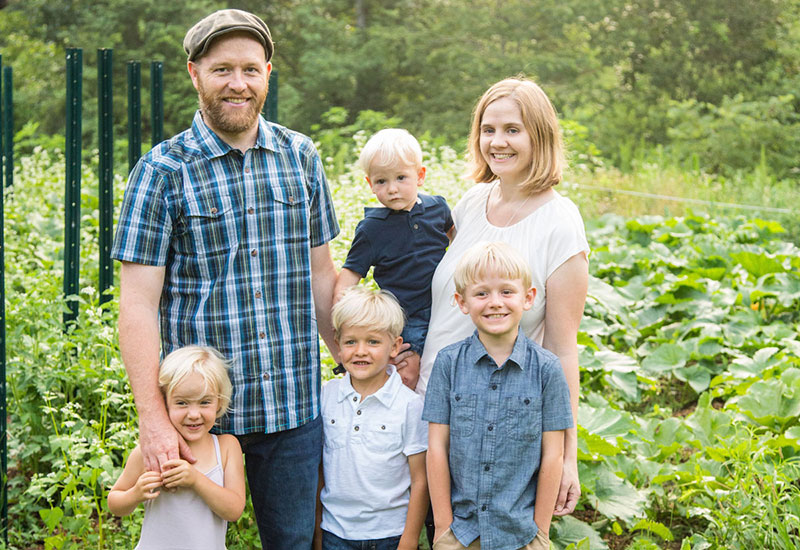And the results are pretty impressive.

“I wanted to do this for myself, but also to inspire and encourage other people, and show them that [living off the land is] easier than you think,” says Rhodes in a phone interview with Modern Farmer. “It’s just about getting up and doing this. Look what you can do in just 100 days. It doesn’t have to be this unattainable thing.”
For the last decade, Rhodes has been homesteading on eight acres in Fletcher, North Carolina. He and his family raise turkeys and chickens (or “dinos” as he’s dubbed them) for meat and eggs, and they typically source about 25 percent of their food from the farm.
Rhodes, who calls himself a “the apron-wearing, permaculture chicken-ninja master” felt they could increase that percentage pretty dramatically and slash their food bill at the same time. But before he began, he set a few ground rules: only 10 hours a week could be spent producing the food; this way Rhodes could prove that it’s doable to live off the land while also working a full-time gig. (Rhodes writes and produces videos for a living.) He notes, though, that he spent a little more time in the beginning prepping, and then less when seeds were in the ground and the chickens had grown.
Rule number two (or really more an allowance, if you will): The family could consume a few grocery-store items, like condiments, dairy (they have a cow, but this was her dry season), and tea with honey. After all, Rhodes didn’t want to make the challenge an “unglamorous, torturous thing,” he says.
The challenge started off slowly. When they began in May, the family was still getting seeds and seedlings into several small plots on less than a half-acre. They planted a wide variety of vegetables, including tomatoes, potatoes, corn, squashes, and greens. They’d also just received their 75 broiler chicks, who arrived a tad early, as you can see in the video below. But by June, midway through the 100 days, the chickens were ready for slaughter and some of the vegetables were ready to be picked, so the grocery-store supplements slowed. By the last month of the challenge, which ended August 13, Rhodes estimates that 75 percent of the food he consumed was what he grew or raised.
The kids and Rhodes’ wife, Rebekah, didn’t participate quite as much, but still not bad: He estimates about 65 percent of their food came from the farm. There were some meals the “chiddlers,” as Rhodes calls his kids, just weren’t into: dehydrated cucumbers, for one, as well as a chicken-and-veggie stir-fry they quickly tired of. (By day three of having that for dinner one of Rhodes’ sons told his dad eating it was his “worst nightmare.”) But generally, Rhodes says, the kids happily ate veggies from the garden, especially when they grew and harvested them.
Rhodes admits there was some stumbling blocks, like the time a snake ate one of their chickens whole (and yes there’s video evidence of that happening, if you have the stomach to watch it). “There will always be some problems,” he says, “you just have to get seeds in the ground and buy some chicks, and if some them die and some seeds don’t make it, just buy more and keep on going. Learn from it.”
Now Rhodes is gearing up for winter. Of the 75 broiler chicks they got in May, 65 lived to slaughter size and provided more than a year’s supply of meat for the family. Plus, he plans to preserve much of the summer harvest to last through the cold months, and is readying root vegetables. “Gosh, I wish you could see my porch. We have pumpkins, winter squash, acorn squash, butternut squash, spaghetti squash, cucumbers,” Rhodes says. “It’s ridiculous. I made the investment during those 100 days in being able to feed myself for a really long time. We just encourage people to do what you can and that’s what we showcased, the easiest things to do: meat chickens, laying hens, and annual vegetables.”
For videos from the entire 100-day challenge, check out Rhodes’ YouTube channel.
I had a spigot for water like you. I needed to know the handle was down at night so I put a bike flag on the handle that I could see from the house that it was put down. Worked well!
We’ve been farming (homesteading) since 2913… Generally to feed ourselves and our grown up family and grandchildren who all live with an hour’s drive. It has definitely been a learning curve but we are doing well the last 3 years. We raise beef,pork, lamb, goat, rabbit, turkey, broiler chickens and ducks. We also have lots of layer hens and some quail. Plus a descent size produce garden. Word got out and more and more people we knew and some we didn’t asked if they could buy some of our food. So in 2016 we bought a bigger property and had… Read more »
I am raising hens discovering a few eggs when cracking open finding a bright yellow yolk and a dark blackness within the yolk.There is no smell or odor from egg shell or yolk. ( the yellow is 80% black 20% or less) Eggs are collected daily stored be for washing. thank you for your help
I love ur shows we watch every day. Ur doing great. Thank u Susan
Hello. I wish to suggest that you name the bull calf, Steakum. We used that name as well as, Burgerboy and Chuky for Chuckroast.
I noticed that justin had to go and buy a 22 and a shotgun for the farm,back in January 2019, for a humane way to put down livestock there is a device used by many small farmers called a captive bolt device. Look on QCsupply.com or any other farm store like tractor supply or a local farm store.